Article and all photos by Joe Mock, BaseballParks.com
All rights reserved
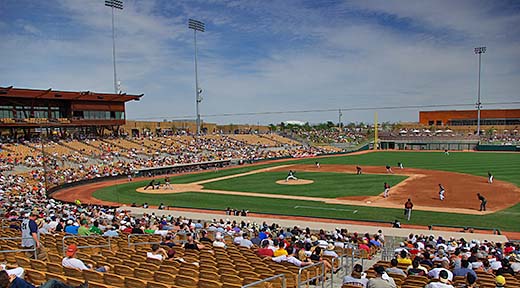 |
If you’re old enough, think about the classic era of TV Westerns. Remember how the ranches on Big Valley, Bonanza and The Virginian were enormous?
| Ballpark Stats |
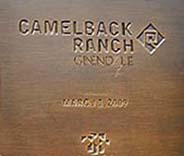 |
| Team: The White Sox and Dodgers play their spring-training games here |
| First game: March 1, 2009 — the White Sox beat the Dodgers 3-2 |
| Capacity: 13,000 (which includes room for 3,000 on the berms) |
| Architect: HKS |
| Construction: Mortenson |
| Price: approximately $100 million for the entire complex |
| Home dugout: First base side for the White Sox, and third base for the Dodgers |
| Field points: Southeast |
| Playing surface: natural grass |
| Betcha didn’t know: Even though Glendale owns this plot of land, it is technically inside the city limits of Phoenix. |
They had nothing on sprawling Camelback Ranch, the new springtime home of the Dodgers and White Sox. This 141-acre complex seems to go on and on, and the ballpark that is the centerpiece (although by no means is it in its center) seems gargantuan … especially when you consider that it was constructed for spring training, not the regular season.
And before we go any further, I have to comment on the construction. I make a point of visiting ballpark sites before, during and (obviously) after the construction takes place. As I visited the site that had been selected for this complex in 2007 and during spring training of 2008, I was startled at the lack of construction that had taken place. In March of 2008, I couldn’t find a single structure that had been started. All I could see was the land being graded.
Six months later , I was positively shocked at how much had been done — but it still seemed like an uphill climb to have everything finished by move-in day, five months away.
Well, when the Dodgers and White Sox arrived to take up residence here in February, it was all done. The folks of Mortenson Construction had performed a miracle in having the complex ready in time — and the quality of the work was phenomenal.
I attended two games at the finished ballpark in March, and I asked one of the ushers what he thought about the construction. He told me that he lived nearby, and for months, he’s heard the sounds of construction coming from the complex at 2:00 and 3:00 in the morning. Indeed, I learned that while an average of 500 workers a day were on site for the first ten months of the construction, that number swelled to about 700 a day during the final four months — and the work went on around the clock. I guess that’s how Mortenson performed this miracle!
Why was this site chosen for the complex, and how did Glendale get two high-profile franchises to agree to move their spring operations here?
First, if you rewind to the beginning of this century, the city of Glendale was not well known — certainly not as a sports mecca. The NFL’s Cardinals played at the outdoor — and outdated — college stadium on the campus of Arizona State University in Tempe. The team had approval to build a new facility, but had been stymied as it tried to find a site near downtown Phoenix.
Meanwhile, the Phoenix Coyotes of the NHL desperately wanted out of the downtown arena that had been designed for basketball. Glendale — with land along the beltway system that was under construction on the western edge of the metro area — became the frontrunner to build a new home for the Coyotes. When the city of 250,000 established a formal “sports and entertainment” district on 23 acres of land along Loop 101, anchored by the hockey facility now known as Jobing.com Arena, the Cardinals’ stadium came along for the ride, and University of Phoenix Stadium became a reality. It’s amusing, of course, that the University of Phoenix doesn’t even field a football team. They just paid for the naming rights of the Cardinals’ mammoth home.
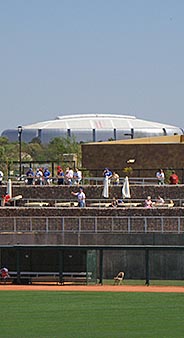 |
“The arena was the catalyst for everything in the area,” Glendale’s assistant deputy city manager Julie Frisoni told the Chicago Sun-Times. “It’s important to remember that in 2001, that entire area was farmland.”
With the $1 billion development now known as Westgate City Center, with hotels, restaurants, clubs, a retractable-roof NFL stadium (shown to the left from within the baseball park) and an NHL arena, Glendale has become an incredible entertainment center. It was only natural that the Dodgers, who preceded the White Sox in discussing the possibility of moving their springtime operations here, would strike a deal with Glendale. Funding from the Arizona Sports and Tourism Authority, along with the participation by the White Sox (who more or less bought their way out of their lease in Tucson), made the deal a reality.
“Over the past eight years, Glendale has made a concerted effort to build a family sports and entertainment district unlike anywhere else in the country,” Frisoni told the Sun-Times. “Sports is our economic engine and sports seems to be somewhat recession-proof.”
At about the same time as the Dodgers were looking to move west, the Indians entered into serious discussions with nearby Goodyear. The new complex in that city opened the same week as the one in Glendale. It, too, was built for two teams, although Goodyear’s second spring-training tenant (the Reds) won’t arrive until 2010.
Comparisons of these two complexes, separated by only 10 miles as the crow flies, are inevitable. You can check out our in-depth review of Goodyear’s park here.
The Setting
Camelback Ranch is located in the “West Valley” of the Phoenix metro area, a mile west of the 101 Loop on, appropriately enough, Camelback Road. Sports fans will be inclined to identify the neighborhood with two large structures that are just to the east of 101 in the sports complex described above: University of Phoenix Stadium, named one of the top ten sports facilities in the world by Business Week, and Jobing.com Arena, which was voted the Best New Concert Venue in 2004 by Pollstar.
The immediate surroundings of the baseball complex are, well, varied. It’s at the corner of 107th Street and Camelback Road, which is basically a residential area. Indeed, there are new single-family homes directly across Camelback Road, and much older homes across 107th Street. There are wide-open spaces to the west of the complex, and that’s quite intentional because the land is just to the south of Glendale’s airport.
A fair amount of new commercial development is planned for some of that land — including a hotel a la Dodgertown in Vero Beach — but at the beginning of the complex’s baseball life, none had been started. To be fair, absolutely none of the development has taken place around Goodyear’s new park, either. In Goodyear, though, the commercial buildings and residential units that are planned will be right next to the ballpark. In Glendale, they will be more on the periphery of the complex.
But what does the 141-acre complex in Glendale look like? Because two teams train here, each has to have its clubhouse (or, in the case of the Dodgers, clubhouses) and practice fields. While Camelback Ranch isn’t the first complex to accommodate two franchises (Peoria, Jupiter, Tucson and Surprise preceded it), it undoubtedly does so with the most style.
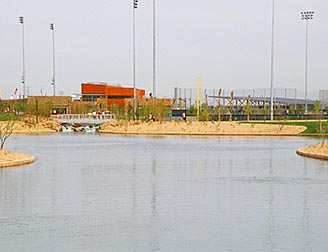  |
That’s because the signature element of the entire project is what separates the two teams. A man-made lake runs between the Dodgers’ fields to the east and the White Sox’ area to the west. The surface area of this body of water is about two acres, and it is as functional as it is beautiful. That’s because it’s used for irrigation for the fields and landscaping. And I have to admit that as far as “signature elements” at or near ballparks go, this is absolutely one of the best.
The main stadium, interestingly, is at the northwest corner of the square complex. While I’m sure there were many reasons why it was placed there, I’m not crazy about it. First, this means that vehicles have to skirt the western edge of the area from Camelback Road to get to the main lots — and, at present, there is only one way in and one way out. Result: traffic bottlenecks, particularly following a game. A new road was paved that leads out of the complex toward the north, but it was barricaded. I had also read that plans originally called for the lot to connect to 107th Street along the eastern edge of the property, but local residents were quite vocal in their opposition, and the plan was scrapped. Good for the locals, but bad for motorists trying to leave the parking lot after a game.
Another parking problem involves a large lot along Camelback in the southeast part of the complex. Fans parking here have quite a long trek through the heart of the practice fields to get to the center-field gates of the ballpark. They do get to enjoy the beautiful lake, though.
The second reason I don’t like the northwest placement of the stadium within the complex is because it forces the playing field to point southeast, and the preferable orientation is northeast or, as the Baseball Rule Book suggests, east by northeast. As a result, the ballpark’s seating bowl receives far less shade than any other spring-training park in Arizona.
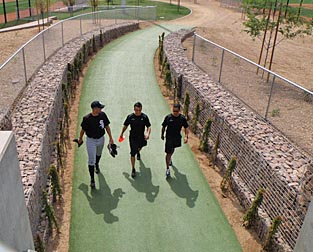  |
One last aspect of the practice fields has to be mentioned. On the White Sox side, players are almost totally insulated from the fans as they walk from and to the clubhouse. There’s even a tunnel for players that is underneath the fans’ main walkway into the complex (above left). The Dodgers, though, have to walk through the middle of their fans to get to their practice fields (above right). This reflects the wishes of the two franchises — and when you think about the wide-open atmosphere that the Dodgers provided at Vero Beach for over half a century, it only makes sense to do it this way in Glendale. Still, I think it’s a shame that White Sox fans who’ve come all the way from Chicago are largely prevented from being able to meet and obtain autographs from their heroes, unless those players put forth special effort to make themselves available.
But even with the parking hassles and the arrangement of the complex, I still think this is the best training complex of any of the 26 in either Florida or Arizona. The landscaping and man-made lake ensure that this is so.
The Exterior
Here’s where we begin to discuss the color scheme of this ballpark, because it is lovely. The exterior of the buildings ringing the stadium features natural-stone veneers, and this masonry work is positively gorgeous. The ones that are simply concrete have been stained mottled colors to resemble desert scenes. Many of the other construction elements are painted to look aged and rusty. “We took our cues from the stark beauty of the desert to create something that was unique to Arizona,” said Dan Phillips of HKS, the architects for this project.
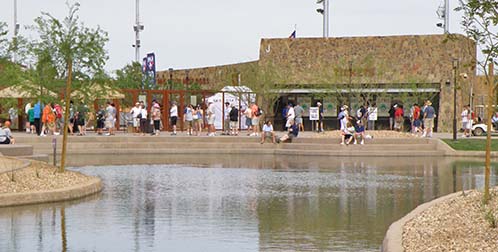 |
The park was actually designed for the main entry point to be in center field, not behind home plate. In fact, the man-made waterway plays in a big role in the aesthetics of this entry plaza (above).
This plaza — which, in a way, is continued in an immense circular plaza just inside these gates — is beautifully arranged, with ticketing on the right (below left). Note the gorgeous stonework of the building.
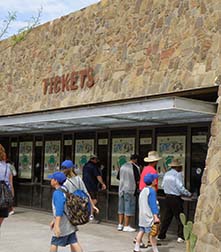 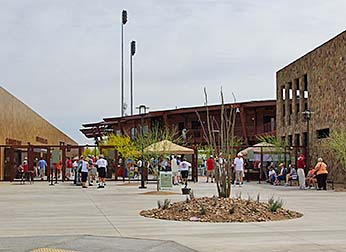 |
There are also entryways behind first base, third base, home plate and near the left-field foul pole. The one behind home plate (above right) keeps the consistent desert look, with its masonry and colors. This look is perpetuated in the park’s exterior in both directions from home plate, and it’s an extremely pleasant and appropriate look at that. The shot below shows that exterior. The home-plate entry is roughly in the center of this photo.
 |
If you look closely at this picture, you’ll notice that none of the roofs are level. That’s because the architects wanted the uneven roof lines to mimic the mountains to the west of the ballpark. Nicely done!